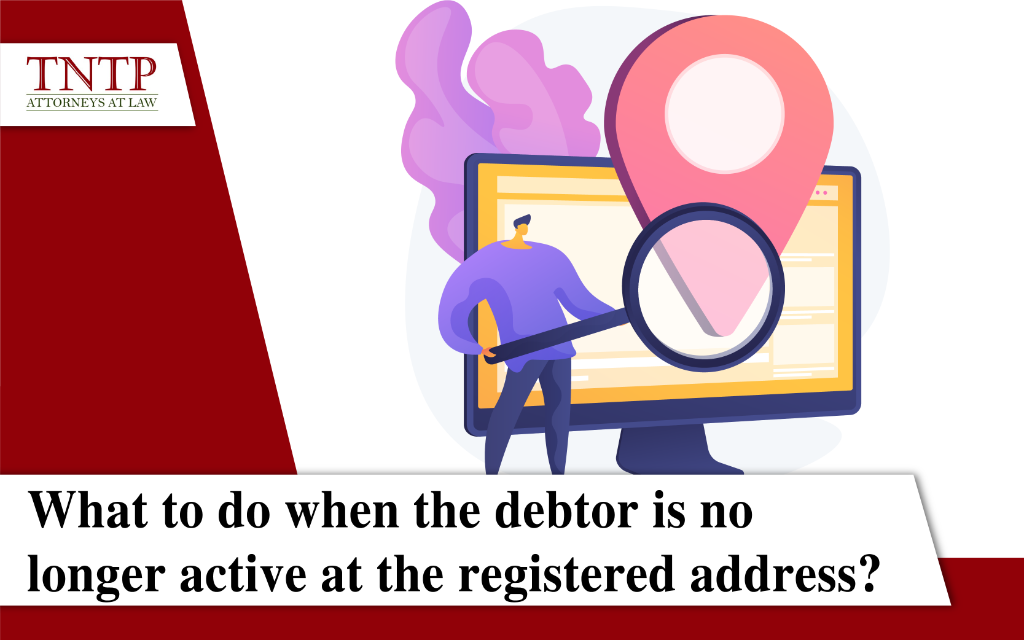What to do when the debtor is no longer active at the registered address?

In debt recovery operations, businesses may encounter situations where the debtor is no longer operating at the registered address. In this case, the business will have difficulties in the debt recovery process, and many businesses may even stop the debt recovery process because they believe that they cannot continue to collect the debt. TNTP will analyze and provide methods and procedures that businesses need to follow when the debtor is no longer operating at the registered address.
1. Is it difficult to collect debts when the debtor is no longer operating at the registered address?
The registered address is an important piece of information to determine the location and operations of the debtor, as well as the basis for verifying the debtor’s operating status. In the case where the debtor is no longer operating at the registered address with the competent authority, it may be due to one of the following reasons:
• The debtor has changed their registered address without notifying the competent authority to update the national portal on business registration.
• The business is no longer operating or has temporarily suspended operations but has not notified the competent authorities to update the information.
• The debtor only declares a “fake” registered address to complete the registration process with the competent authority, while operating at a different address.
In reality, many debtors do not disclose their operating address or change their address without notifying the authorities to avoid their debts from their creditors. Therefore, businesses that cannot determine the actual address of the debtor will have difficulties in taking debt recovery measures such as contacting to exchange, urging, and requesting the debtor to pay through official letters or directly exchanging to request payment.
2. How do companies recover debts from longer active debtors at registered addresses?
It can be seen that failure to determine the exact address of the debtor will create difficulties in implementing debt recovery measures. However, companies can still carry out necessary tasks to serve debt recovery as follows:
a) Complaint to the tax authority managing the debtor
According to the provisions of the law, each company must pay taxes according to regulations while operating, and tax collection will be directly managed by authorized tax agencies according to the corresponding administrative boundaries. Therefore, in case a company identifies that the longer active debtor is not at the registered address, it has the right to complain to the competent tax agencies about the longer active debtor at the registered address.
After receiving the information, the competent tax agencies will carry out initial verification tasks regarding whether the debtor is still operating at the registered office address. In case the tax agencies have sufficient basis to verify that the debtor is no longer operating at the registered address without notifying to update information on the change of the office address, they may be administratively sanctioned, or even have their tax identification number revoked. Closing the tax identification number will make the debtor unable to perform tasks such as tax payment or invoice issuance, in other words, it will seriously affect the debtor’s operation process. If the debtor wants to restore their tax identification number, they will have to contact the competent tax agencies to restore the tax identification number and pay related costs, as well as provide an accurate office address to prove their operation. Therefore, this is an effective measure to handle longer active debtors at registered addresses.
b) Initiating legal proceedings against the debtor at the competent court
When it is not possible to contact and verify the address of the debtor, the business can still initiate legal proceedings at the court. In this case, the business can request the court to assist in verifying the address of the debtor through competent authorities. As the court is a judicial agency, requesting competent authorities to verify the debtor’s address will ensure a faster process than if the business were to request state authorities to verify the debtor’s information on their own.
Legal proceedings at the court will be carried out according to the provisions of the Civil Procedure Code. The business needs to provide sufficient information and documents to prove its claim for debt recovery, as well as evidence that they have taken all measures to verify the debtor’s address but has not obtained any results, as a basis for requesting the court’s assistance in verifying the debtor’s address.
After the court has performed the tasks to assist the business in verifying the debtor’s address, but no results have been obtained, the court will still proceed with the litigation process according to the provisions of the law to issue a legally effective Decision/Judgment. Even if the debtor does not participate in the litigation process, they will still be responsible for paying the debt to the business.
After the Decision/Judgment of the court becomes legally effective, the business can request the competent authority to carry out the enforcement stage. At this point, the competent enforcement agency will act on behalf of the state to take necessary measures to verify, and seal the accounts, assets, and account information of the debtor, forcing them to fulfill their obligation to enforce the Decision/Judgment.
The above is an article on the topic of “What to do when the debtor is no longer operating at the registered address?” by TNTP. It is hoped that this article will be helpful in the debt recovery process for businesses.
Sincerely,



